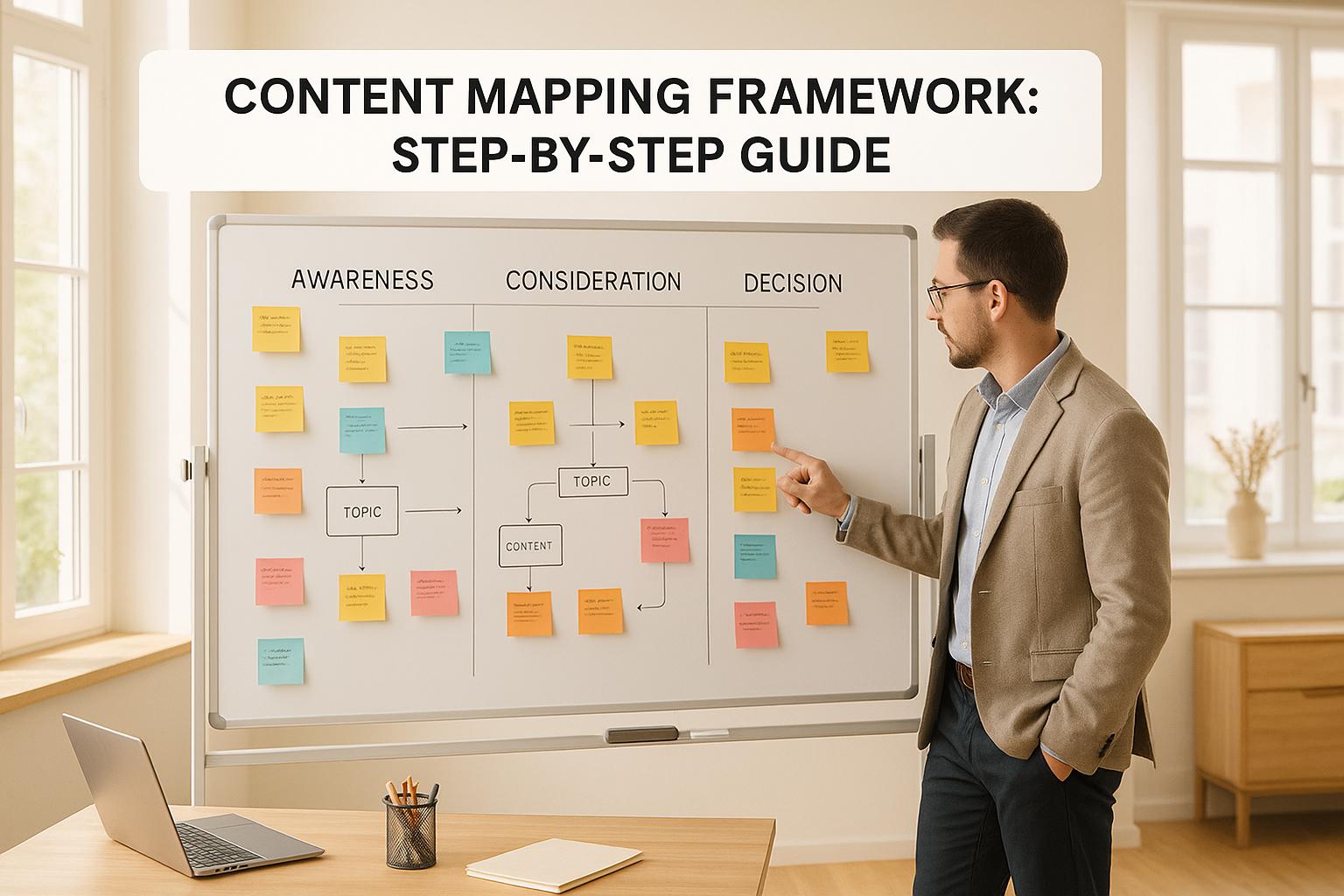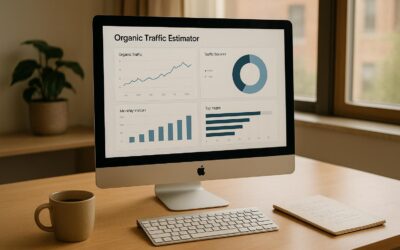Content mapping helps you connect your content to your audience’s needs at every stage of their buyer journey. It improves engagement, boosts search rankings, and turns visitors into leads. Here’s how it works:
- Understand Your Audience: Create detailed personas with demographics, behavior, pain points, and goals.
- Match Content to Buyer Stages: Use educational content for awareness, detailed guides for consideration, and demos or case studies for decision-making.
- Choose the Right Formats: Pick content types (e.g., blogs, videos, guides) based on audience preferences and search intent.
- Use Data to Refine: Analyze website metrics, gather feedback, and identify gaps to improve your strategy.
Quick Overview:
| Step | What to Do |
|---|---|
| Create Personas | Understand audience demographics & behavior |
| Map Buyer Stages | Align content with awareness, consideration, and decision phases |
| Research & Analyze | Use analytics, surveys, and market research |
| Plan & Optimize | Regularly update and adjust based on performance |
Start with a content audit, focus on one persona or stage, and continuously monitor results to ensure your content delivers the right message to the right audience.
What Is Content Mapping And How To Use It 🧭✍🏽✅📈 Become The Best Content Creator #DigitalMarketing
Key Elements of Content Mapping
Content mapping revolves around three essential components that help deliver effective results. Let’s break them down.
Creating Audience Personas
To create audience personas, you need to gather specific data about your target audience. This includes demographic details, behavior patterns, and their goals or challenges. Here’s how you can structure it:
- Demographic Data: Information like age, location, income level, and job titles.
- Behavioral Patterns: Insights into their online activities and content preferences.
- Pain Points: The challenges or problems they face.
- Goals: What they hope to accomplish.
| Persona Element | Data Source | Key Insights to Gather |
|---|---|---|
| Demographics | Analytics Tools | Age, location, device usage |
| Behavior | User Sessions | Time on site, content preferences |
| Intent | Search Queries | Problem-solving needs, goals |
| Engagement | Interaction Data | Preferred content formats |
By grounding your personas in real data, you can better tailor your content to resonate with your audience.
Content for Each Buying Stage
Different stages of the buying journey require different types of content. Here’s what works best at each stage:
- Awareness Stage: Focus on educational content like blog posts about industry concepts, how-to guides that address common challenges, and reports on trends or research.
- Consideration Stage: Provide more detailed information like product comparisons, case studies that showcase results, and expert insights through interviews.
- Decision Stage: Help potential buyers take the final step with product demos, implementation guides, and tools like ROI calculators.
"We craft tailored SEO plans based on your business’s unique needs. From day one, we focus on what matters most to you – whether it’s increasing leads, boosting conversions, or improving rankings." – SearchX
Choosing Content Types
Selecting the right content format is critical. Consider these factors when deciding:
- How your audience prefers to consume content.
- The complexity of the topic you’re covering.
- The level of detail your audience expects.
- The resources you have available for creating content.
Match your content formats to search intent and keyword strategies. For instance, if your analytics show that your audience prefers in-depth information, consider turning general blog posts into detailed guides. The goal is to consistently align your content with audience needs at every stage of their journey, ensuring higher engagement and better conversions.
Research Methods for Content Mapping
To create an effective content mapping strategy, you need solid research methods to truly understand your audience and their needs. Here’s how you can gather and analyze the data that will shape your approach.
Website Analytics Review
Your website analytics are a goldmine for understanding user behavior. Pay attention to these metrics to guide your content decisions:
- Page Performance: Identify the content that drives the most engagement.
- User Flow: Study how visitors move through your site.
- Search Queries: Pinpoint the terms users search for to find your content.
- Time on Page: Gauge how long visitors are staying engaged with your content.
| Metric Type | What to Track | Action Items |
|---|---|---|
| Engagement | Avg. time on page, bounce rate | Discover which content formats perform best. |
| Navigation | Entry/exit pages, user paths | Improve internal linking and content layout. |
| Conversion | Goal completion rates | Align content with key conversion points. |
| Search | Internal search terms | Address gaps and refine based on user intent. |
Once you’ve reviewed your analytics, the next step is to get direct input from your audience.
Direct Audience Feedback
Hearing directly from your audience is essential for validating your strategy. Here are a few ways to gather their input:
- User Surveys: Use surveys to ask specific questions about their content preferences.
- Comments Analysis: Review the discussions happening in your blog comments or forums.
- Social Listening: Keep an eye on social media mentions and interactions to understand what resonates.
"SearchX isn’t just an SEO provider – we’re an extension of your team, focused on accelerating your growth."
By combining this feedback with broader market insights, you can spot new opportunities.
Market Gap Analysis
A thorough look at your market can uncover areas where your content might be falling short. Here’s how to approach it:
Topic Research
- Study search intent to understand what your audience is looking for.
- Identify areas where content is lacking or underserved.
- Match keyword opportunities with the right content formats.
Content Audit
- Review the performance of your existing content.
- Identify pieces that could be updated, expanded, or improved.
- Plan new content to address gaps or meet emerging needs.
"We drive measurable results."
Setting Up Your Content Map
Your research insights are the foundation for creating a content map that keeps users engaged. By organizing your CMS to match the buyer’s journey, you can ensure your content meets their needs at every stage.
CMS Content Structure
Your CMS should reflect your audience’s journey through a well-organized content hierarchy.
Content Categories
- Establish clear parent-child relationships to connect related content.
- Use tags to indicate which stage of the buyer’s journey each piece addresses.
- Apply consistent naming conventions to maintain clarity across all content types.
| Content Level | Purpose | Example Structure |
|---|---|---|
| Primary | Main topic areas | Products, Solutions, Resources |
| Secondary | Specific subtopics | Product Features, Use Cases |
| Tertiary | Individual content pieces | Tutorials, Case Studies |
Content Personalization
Delivering the right content to the right audience is key. Personalization should align with user behavior to make your content more relevant.
Dynamic Content Rules
- Set up triggers based on user actions to deliver tailored content.
- Segment your audience by tracking engagement patterns.
- Provide multiple content variations to suit different user profiles.
Always monitor performance and tweak your approach to keep improving.
Content Flow Planning
A well-thought-out content flow keeps users engaged by guiding them naturally through their journey.
Content Journey Mapping
- Design clear pathways that move users from awareness to decision-making.
- Add internal links that seamlessly guide users to related content.
- Place calls-to-action strategically to encourage the next step.
| Journey Stage | Content Type | Next Step Trigger |
|---|---|---|
| Awareness | Educational blog posts | Related topic deep-dives |
| Consideration | Detailed guides | Product comparisons |
| Decision | Case studies | Demo requests |
Adapt your content strategy to fit your business objectives, whether you’re aiming to increase traffic, generate leads, or drive conversions.
Measuring Content Map Results
Key Performance Metrics
To determine how well your content map is working, track metrics that highlight user engagement and the effectiveness of your content.
Engagement Metrics to Keep an Eye On
| Metric Type | What to Track | Target Goal |
|---|---|---|
| User Behavior | Time on page, scroll depth, bounce rate | 3+ minutes, 75% scroll, <40% bounce |
| Content Performance | Page views, social shares, backlinks | 20% monthly growth |
| Conversion Actions | Downloads, form fills, demo requests | 5% conversion rate |
Pay attention to how users navigate through your content pathways. This will help you spot bottlenecks or gaps in their journey. From there, you can evaluate how these metrics contribute to your broader business goals.
Revenue Impact Analysis
To connect content performance to revenue, measure engagement against these indicators:
- Lead quality scores: Are the leads generated by your content high-value?
- Sales cycle duration: Does your content help shorten the time to close a sale?
- Customer lifetime value: Are you attracting long-term, profitable customers?
- Conversion rates at each funnel stage: How effectively is your content moving users through the funnel?
By tying high-performing content to revenue outcomes, you’ll gain a clearer picture of its impact. Use this insight to refine your strategy and ensure your content continues to drive meaningful results.
Content Update Schedule
Regular updates are essential to keep your content map aligned with your audience’s changing needs. Use a structured framework to review and refresh your content.
Review Framework
| Timeframe | Action Items | Indicators |
|---|---|---|
| Monthly | Performance analysis, keyword relevance check | Traffic trends, ranking changes |
| Quarterly | Content gap analysis, competitor research | Expanded market coverage, gaps filled |
| Annually | Full content audit, strategy alignment | Revenue impact, goal achievement |
Make adjustments based on performance data to keep your content effective:
- Update and improve content to better match search intent and increase conversions.
- Refresh or remove underperforming content to avoid clutter and maintain quality.
- Add new material to address gaps and meet emerging audience needs.
Be sure to document any changes and their outcomes. This will provide valuable insights for future planning and help you stay on track with your goals.
Next Steps
Now that you’ve got your metrics sorted, it’s time to put your content mapping framework into action. Follow these steps to ensure you see measurable results.
Start With a Content Audit
The first step is to audit your existing content using your mapping framework. Pinpoint content that aligns with specific stages of the customer journey. This will give you a solid starting point for your strategy while preserving what’s already working.
Plan Your Implementation Timeline
Set up a clear timeline to guide your efforts. Here’s an example of how you can structure it:
| Phase | Duration | Key Activities | Success Indicators |
|---|---|---|---|
| Foundation | 30 days | Content audit, gap analysis, initial mapping | Baseline metrics established |
| Development | 60–90 days | New content creation, CRM integration | Content coverage for key stages |
| Optimization | Ongoing | Performance tracking, personalization | Increased engagement rates |
Once your timeline is in place, you’ll be ready to integrate your systems and keep things moving forward.
Integrate Your Technology Stack
To make everything work seamlessly, connect your content mapping framework with your primary business systems. Start with your CRM and marketing automation tools. These integrations will help you track how your content performs throughout the customer journey and allow you to deliver tailored experiences based on user behavior.
Streamline Your Content Production Workflow
After your systems are set up, focus on creating a smooth production process. A solid workflow should include:
- Content briefs tailored to specific journey stages
- Review steps to ensure accuracy in mapping
- Distribution plans for each piece of content
- Protocols for tracking performance
Consistency is key, so make sure your team is aligned and processes are clear.
Test With One Buyer Persona or Journey Stage
Don’t try to tackle everything at once. Start small by focusing on one buyer persona or specific stage of the journey. This approach will help you validate your framework, fine-tune your process, and build confidence within your team while achieving some quick wins.
Keep Monitoring and Adjusting
Your content mapping framework isn’t a one-and-done deal – it should grow along with your business. Plan quarterly reviews to evaluate:
- How your content is performing
- How users are progressing through their journey
- The impact on revenue
- Any new content gaps that arise
FAQs
How can I create audience personas to enhance my content mapping framework?
Creating Audience Personas
Building audience personas is a crucial step in crafting a content mapping framework that truly connects with your audience. Start by gathering insights about your target audience. Look at demographic data (like age, location, and profession), behavioral patterns (such as online habits or purchase history), and pain points (the challenges they face). Use tools like surveys, interviews, and analytics to dig deeper into their preferences, struggles, and goals.
Once you’ve collected this information, divide your audience into distinct groups with shared traits. For each group, create a detailed persona that outlines their key attributes – things like their interests, specific needs, and motivations. These personas act as a guide to help you craft content that speaks directly to their concerns and leads them smoothly through the buyer’s journey.
When your content aligns with these personas, it’s more likely to hit the mark. Your messaging will feel more relevant, boosting engagement and driving stronger results for your overall strategy.
How can I effectively align content with each stage of the buyer’s journey?
To create content that resonates with your audience, it’s crucial to match it to the specific stages of the buyer’s journey. Each step comes with unique needs and expectations, and your content should address them directly.
In the awareness stage, your audience is just beginning to identify their challenges or questions. This is the time to deliver educational and informative materials. Think blog posts, infographics, or videos that shed light on common problems or provide helpful insights.
As buyers move into the consideration stage, they’re exploring potential solutions. Here, more detailed resources work best. Case studies, whitepapers, and comparison guides can help them weigh their options and understand how your offerings stand out.
Finally, in the decision stage, your audience is ready to choose. This is your opportunity to share persuasive content like testimonials, product demos, or even free trials. These tools can give that final nudge toward conversion.
By aligning your content with these stages, you not only guide your audience more effectively but also deepen their connection with your brand.
How can I evaluate the success of my content mapping framework in driving engagement and conversions?
To gauge how well your content mapping framework is performing, keep an eye on key performance indicators (KPIs) that match your specific objectives. For engagement, focus on metrics like time spent on a page, bounce rate, and social shares. When it comes to conversions, track lead generation, click-through rates (CTR), and sales or sign-ups that can be directly tied to your content.
Tools like Google Analytics can be incredibly helpful for understanding user behavior and pinpointing which pieces of content resonate most with your audience. By regularly analyzing these insights, you can fine-tune your framework to ensure it consistently delivers measurable outcomes.




